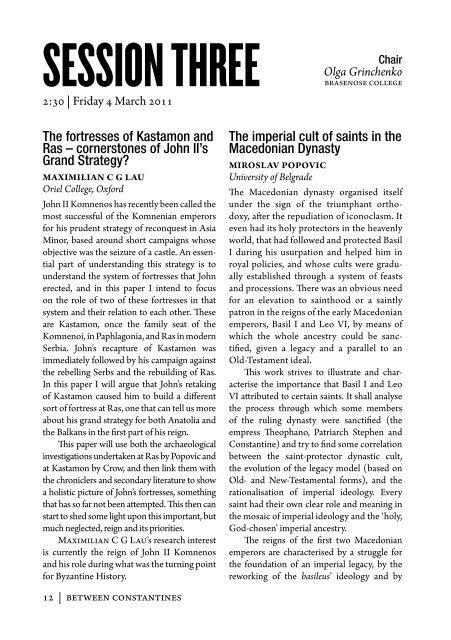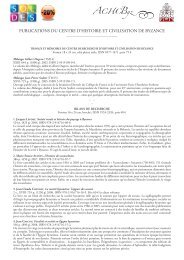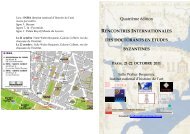booklet of abstracts - Oxford University Byzantine Society
booklet of abstracts - Oxford University Byzantine Society
booklet of abstracts - Oxford University Byzantine Society
Create successful ePaper yourself
Turn your PDF publications into a flip-book with our unique Google optimized e-Paper software.
Session Three2:30 | Friday 4 March 2011ChairOlga GrinchenkoBrasenose CollegeThe fortresses <strong>of</strong> Kastamon andRas – cornerstones <strong>of</strong> John II’sGrand Strategy?Maximilian C G LauOriel College, <strong>Oxford</strong>John II Komnenos has recently been called themost successful <strong>of</strong> the Komnenian emperorsfor his prudent strategy <strong>of</strong> reconquest in AsiaMinor, based around short campaigns whoseobjective was the seizure <strong>of</strong> a castle. An essentialpart <strong>of</strong> understanding this strategy is tounderstand the system <strong>of</strong> fortresses that Johnerected, and in this paper I intend to focuson the role <strong>of</strong> two <strong>of</strong> these fortresses in thatsystem and their relation to each other. Theseare Kastamon, once the family seat <strong>of</strong> theKomnenoi, in Paphlagonia, and Ras in modernSerbia. John’s recapture <strong>of</strong> Kastamon wasimmediately followed by his campaign againstthe rebelling Serbs and the rebuilding <strong>of</strong> Ras.In this paper I will argue that John’s retaking<strong>of</strong> Kastamon caused him to build a differentsort <strong>of</strong> fortress at Ras, one that can tell us moreabout his grand strategy for both Anatolia andthe Balkans in the first part <strong>of</strong> his reign.This paper will use both the archaeologicalinvestigations undertaken at Ras by Popovic andat Kastamon by Crow, and then link them withthe chroniclers and secondary literature to showa holistic picture <strong>of</strong> John’s fortresses, somethingthat has so far not been attempted. This then canstart to shed some light upon this important, butmuch neglected, reign and its priorities.Maximilian C G Lau’s research interestis currently the reign <strong>of</strong> John II Komnenosand his role during what was the turning pointfor <strong>Byzantine</strong> History.The imperial cult <strong>of</strong> saints in theMacedonian DynastyMiroslav Popovic<strong>University</strong> <strong>of</strong> BelgradeThe Macedonian dynasty organised itselfunder the sign <strong>of</strong> the triumphant orthodoxy,after the repudiation <strong>of</strong> iconoclasm. Iteven had its holy protectors in the heavenlyworld, that had followed and protected BasilI during his usurpation and helped him inroyal policies, and whose cults were graduallyestablished through a system <strong>of</strong> feastsand processions. There was an obvious needfor an elevation to sainthood or a saintlypatron in the reigns <strong>of</strong> the early Macedonianemperors, Basil I and Leo VI, by means <strong>of</strong>which the whole ancestry could be sanctified,given a legacy and a parallel to anOld-Testament ideal.This work strives to illustrate and characterisethe importance that Basil I and LeoVI attributed to certain saints. It shall analysethe process through which some members<strong>of</strong> the ruling dynasty were sanctified (theempress Theophano, Patriarch Stephen andConstantine) and try to find some correlationbetween the saint-protector dynastic cult,the evolution <strong>of</strong> the legacy model (based onOld- and New-Testamental forms), and therationalisation <strong>of</strong> imperial ideology. Everysaint had their own clear role and meaning inthe mosaic <strong>of</strong> imperial ideology and the ‘holy,God-chosen’ imperial ancestry.The reigns <strong>of</strong> the first two Macedonianemperors are characterised by a struggle forthe foundation <strong>of</strong> an imperial legacy, by thereworking <strong>of</strong> the basileus’ ideology and by12 | Between Constantines





